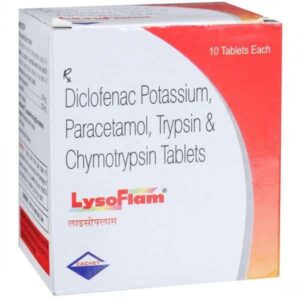DICLOFENAC + CHYMOTRYPSIN
Diclofenac: Diclofenac is a nonsteroidal anti-inflammatory drug (NSAID) that is commonly used to relieve pain, inflammation, and stiffness caused by various conditions such as arthritis, osteoarthritis, and ankylosing spondylitis.
The mechanism of action of diclofenac involves inhibiting the production of prostaglandins in the body. Prostaglandins play a key role in promoting inflammation, pain, and fever. By blocking their production, diclofenac effectively reduces these symptoms.
Diclofenac comes in various forms including tablets, capsules, gel, solution, and patches. The dosage may vary depending on the individual, the severity of the condition being treated, and the prescribed form of diclofenac. It is important to follow the instructions provided by the healthcare professional or indicated on the packaging.
Common side effects of diclofenac include stomach pain, heartburn, nausea, diarrhea, headache, dizziness, and drowsiness. In rare cases, diclofenac can cause more serious side effects such as severe allergic reactions, stomach ulcers, liver or kidney problems, and cardiovascular events like heart attack or stroke. Individuals with a history of cardiovascular disease or who are at high risk should exercise caution when using diclofenac.
Diclofenac should not be taken by individuals who are allergic to NSAIDs, those who have experienced asthma, hives, or other allergic reactions after taking aspirin or other NSAIDs, or those who have active stomach or intestinal ulcers. It is important to inform your healthcare provider about any medical conditions, medications, or supplements you are taking before starting diclofenac.
As with any medication, it is essential to follow the prescribed dosage and consult a healthcare professional if any concerning side effects occur.
Chymotrypsin: Chymotrypsin is a proteolytic enzyme drug that is used in the field of medicine. It is primarily used for its proteolytic activity, which means it helps in breaking down proteins into smaller peptides.
The mechanism of action of Chymotrypsin involves its ability to cleave peptide bonds in proteins. Specifically, it targets peptide bonds adjacent to aromatic amino acids such as phenylalanine, tryptophan, and tyrosine. This enzymatic activity helps in the digestion and absorption of proteins in the gastrointestinal tract.
In medicine, Chymotrypsin is commonly used in ophthalmic procedures. It is administered as eye drops to help in the breakdown of proteins that may accumulate in the eye. This can be helpful in reducing inflammation, edema, and clearing the visual axis during various surgical procedures, such as cataract surgery.
The dose of Chymotrypsin can vary depending on the specific procedure and the severity of the condition being treated. It is usually administered by healthcare professionals and the dosage is determined based on individual patient needs.
As with any medication, Chymotrypsin may have some side effects. Common side effects may include temporary eye irritation, itching, redness, or a feeling of grittiness in the eye. These side effects are usually mild and temporary.
Rarely, more serious side effects such as severe allergic reactions, eye infections, or increased intraocular pressure may occur. If any unusual or severe side effects occur, it is important to seek medical attention immediately.
Overall, Chymotrypsin is an important drug in ophthalmology and has proven to be effective in assisting with protein breakdown during certain surgical procedures. However, it should always be used under the guidance of a healthcare professional to minimize the risk of side effects and ensure proper administration.

